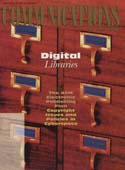Copyright and digital libraries
April 1995 - Vol. 38 No. 4

Features
Rich interaction in the digital library
The MG retrieval system: compressing for space and speed
NSF Center for Intelligent Information Retrieval
World-Wide Web and computer science reports
Wide Area Technical Report Service: technical reports online
Dienst: an architecture for distributed document libraries
Knowledge-based editing and visualization for hypermedia encyclopedias
The University of California CD-ROM Information System
Envision: a user-centered database of computer science literature
Making a digital library: the chemistry online retrieval experiment
An appreciation of Laurence Rosenberg
Informedia Digital Video Library
The Stanford Digital Library Project
UC Berkeley’s Digital Library project
Building the interspace: the Illinois Digital Library Project
University of Michigan Digital Library Project
The British Library’s initiatives for access projects
Library of Congress Digital Library effort
The roles of digital libraries in teaching and learning
Going digital: a look at assumptions underlying digital libraries
Digital libraries, value, and productivity
The ACM electronic publishing plan



